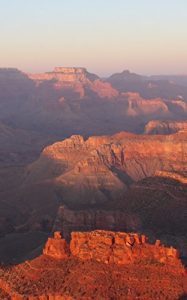In The Grand Canyon to Yellowstone: A View from a Busy Mind, I touch on quite a few interesting subjects. Below are a few topics I answer or discuss.
•Is the Grand Canyon really awful?
•What does Moab have to do with the speed of light?
•What does the Grand Canyon have to do with the second law of thermodynamics?
•Where exactly is the dreaded two-headed hemi-spewing manatee of southern Utah?
•How did Dead Horse State Park really get its name?
•$35, $49—What’s the Difference?
•Is it buffalo or bison?
•What does the Grand Canyon of the Yellowstone have to do with Mars?
•Where do Canadian geese come from?
•Why are the receding cheeks of formal oil portraits green and what does this have to do with the Grand Canyon?
The Grand Canyon to Yellowstone: A View from a Busy Mind is not a guide to national or state parks—there are many fine books out there for that purpose. The Grand Canyon to Yellowstone: A View from a Busy Mind describes what was going through my head as I looked about in such places. With my varied background, I see art and science collide wherever I look. Some thoughts may make sense, others are really out there and nobody can see them coming (often, not even me). I visit Arches and Canyonlands National Parks and take a rafting trip while visiting Moab. I then go to The Grand Canyon where my thoughts of art, science, and color all blend together as I gaze at this awesome canyon. I visit St. George Utah on the way to Death Valley, spin by Las Vegas, and then up to Yellowstone, one of the most magical places I have ever visited.
The idea of this book is that it is not only the places you visit, but what goes through each person’s mind that makes any trip unique to that individual. In today’s modern world, doctors probably have a syndrome named for a mind like mine, but where some people may view this as a distraction, I feel I turn it into a positive.
Certainly people that are about to visit or have already visited these places will be familiar with the locations, but I feel this is not a requirement for reading this book. I feel all reading is for entertainment and The Grand Canyon to Yellowstone: A View from a Busy Mind is no different. My goal is that most people will find portions interesting or amusing. If someone reads it and says something like, “I didn’t know that,” then that is a good thing. My apologies to the people that read this and then become distracted when vacationing, not being able to fully focus on what is in front of them, but I certainly see this as a bonus, not a distraction. So the next time you watch the movie Cars with your children or grandchildren and your mind wanders to giant spiders crawling on the desert floor, you can blame me (and I sincerely apologize).
•Is the Grand Canyon really awful?
•What does Moab have to do with the speed of light?
•What does the Grand Canyon have to do with the second law of thermodynamics?
•Where exactly is the dreaded two-headed hemi-spewing manatee of southern Utah?
•How did Dead Horse State Park really get its name?
•$35, $49—What’s the Difference?
•Is it buffalo or bison?
•What does the Grand Canyon of the Yellowstone have to do with Mars?
•Where do Canadian geese come from?
•Why are the receding cheeks of formal oil portraits green and what does this have to do with the Grand Canyon?
The Grand Canyon to Yellowstone: A View from a Busy Mind is not a guide to national or state parks—there are many fine books out there for that purpose. The Grand Canyon to Yellowstone: A View from a Busy Mind describes what was going through my head as I looked about in such places. With my varied background, I see art and science collide wherever I look. Some thoughts may make sense, others are really out there and nobody can see them coming (often, not even me). I visit Arches and Canyonlands National Parks and take a rafting trip while visiting Moab. I then go to The Grand Canyon where my thoughts of art, science, and color all blend together as I gaze at this awesome canyon. I visit St. George Utah on the way to Death Valley, spin by Las Vegas, and then up to Yellowstone, one of the most magical places I have ever visited.
The idea of this book is that it is not only the places you visit, but what goes through each person’s mind that makes any trip unique to that individual. In today’s modern world, doctors probably have a syndrome named for a mind like mine, but where some people may view this as a distraction, I feel I turn it into a positive.
Certainly people that are about to visit or have already visited these places will be familiar with the locations, but I feel this is not a requirement for reading this book. I feel all reading is for entertainment and The Grand Canyon to Yellowstone: A View from a Busy Mind is no different. My goal is that most people will find portions interesting or amusing. If someone reads it and says something like, “I didn’t know that,” then that is a good thing. My apologies to the people that read this and then become distracted when vacationing, not being able to fully focus on what is in front of them, but I certainly see this as a bonus, not a distraction. So the next time you watch the movie Cars with your children or grandchildren and your mind wanders to giant spiders crawling on the desert floor, you can blame me (and I sincerely apologize).












